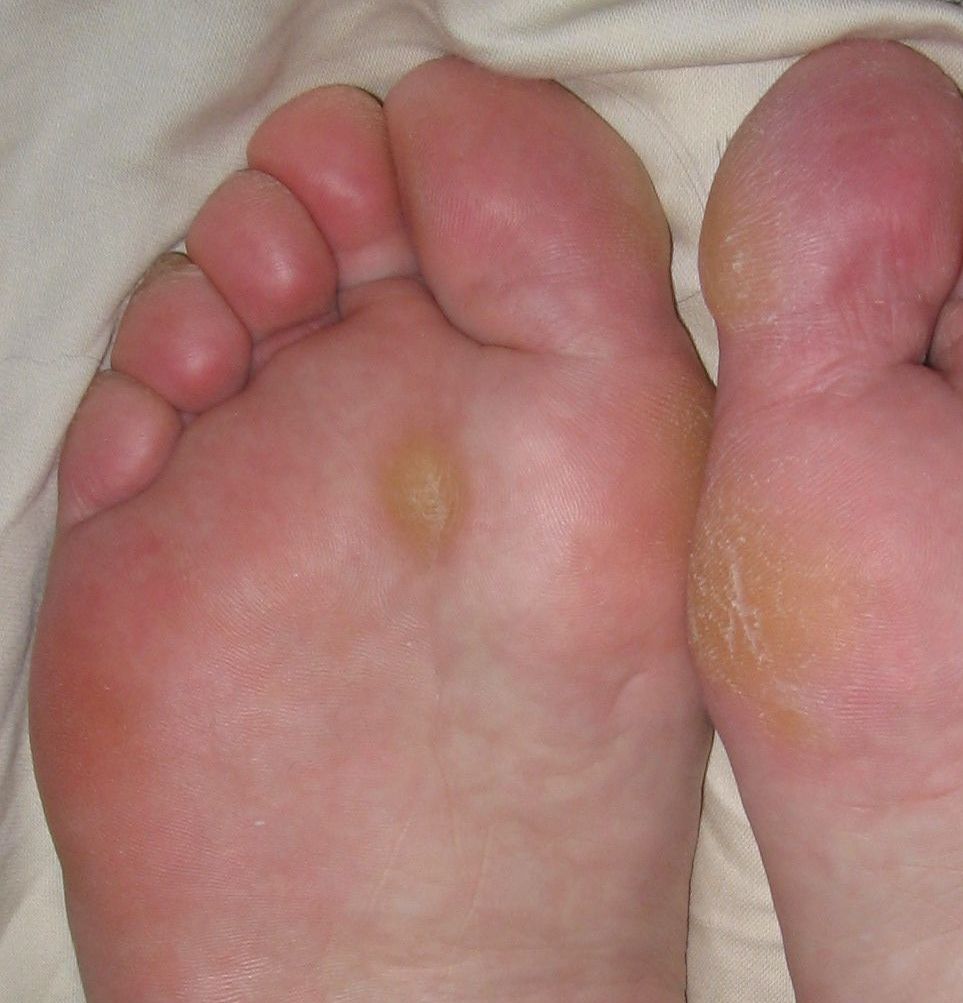|
Callus
A callus is an area of thickened and sometimes hardened skin that forms as a response to repeated friction, pressure, or other irritation. Since repeated contact is required, calluses are most often found on the feet and hands, but they may occur anywhere on the skin. Some degree of callus, such as on the bottom of the foot, is normal. Calluses are generally not harmful and help prevent blisters, as well as offering protection. However, excessive formation may sometimes lead to other problems, such as a skin ulceration or infection, or cause the affected person to try to offload the affected painful area, which can place excessive stress on the asymptomatic side. Rubbing that is too frequent or forceful will cause blisters, as opposed to calluses, to form. Cause Normally, a callus will form on any part of the skin exposed to excess friction over a long period of time. Activities that are known for causing calluses include (but are not limited to) construction work, many spo ... [...More Info...] [...Related Items...] OR: [Wikipedia] [Google] [Baidu] |
Blister
A blister is a small pocket of body fluid ( lymph, serum, plasma, blood, or pus) within the upper layers of the skin, usually caused by forceful rubbing (friction), burning, freezing, chemical exposure or infection. Most blisters are filled with a clear fluid, either serum or plasma. However, blisters can be filled with blood (known as " blood blisters") or with pus (for instance, if they become infected). The word "blister" entered English in the 14th century. It came from the Middle Dutch and was a modification of the Old French , which meant a leprous nodule—a rise in the skin due to leprosy. In dermatology today, the words ''vesicle'' and ''bulla'' refer to blisters of smaller or greater size, respectively. To heal properly, a blister should not be popped unless medically necessary. If popped, the bacteria can spread. The excess skin should not be removed because the skin underneath needs the top layer to heal properly. Causes A blister may form when the skin ha ... [...More Info...] [...Related Items...] OR: [Wikipedia] [Google] [Baidu] |
Rock Climbing
Rock climbing is a sport in which participants climb up, across, or down natural rock formations. The goal is to reach the summit of a formation or the endpoint of a usually pre-defined route without falling. Rock climbing is a physically and mentally demanding sport, one that often tests a climber's strength, endurance, agility and balance along with mental control. Knowledge of proper climbing techniques and the use of specialized climbing equipment is crucial for the safe completion of routes. Because of the wide range and variety of rock formations around the world, rock climbing has been separated into several different styles and sub-disciplines, such as scrambling, bouldering, sport climbing, and trad (traditional) climbing another activity involving the scaling of hills and similar formations, differentiated by the rock climber's sustained use of hands to support their body weight as well as to provide balance. Rock climbing competitions have the objectives of e ... [...More Info...] [...Related Items...] OR: [Wikipedia] [Google] [Baidu] |
High Heels
High-heeled shoes, also known as high heels, are a type of shoe with an angled sole. The heel in such shoes is raised above the ball of the foot. High heels cause the legs to appear longer, make the wearer appear taller, and accentuate the calf muscle. There are many types of heels in varying colors, materials, styles, and heights. High heels have been used in various ways to communicate nationality, professional affiliation, gender, and social status. High heels have been important in the West. In early 17th century Europe, for example, high heels were a sign of masculinity and high social status. It wasn't until the end of the century that this trend spread to women's fashion. By the 18th century, high-heeled shoes had split along gender lines. By this time, heels for men's shoes were chunky squares attached to riding boots or tall formal dress boots while women's high heels were narrow and pointy and often attached to slipper-like dress shoes (similar to modern heels). ... [...More Info...] [...Related Items...] OR: [Wikipedia] [Google] [Baidu] |
Rowing (sport)
Rowing, sometimes called crew in the United States, is the sport of racing boats using oars. It differs from paddling sports in that rowing oars are attached to the boat using oarlocks, while paddles are not connected to the boat. Rowing is divided into two disciplines: sculling and sweep rowing. In sculling, each rower holds two oars—one in each hand, while in sweep rowing each rower holds one oar with both hands. There are several boat classes in which athletes may compete, ranging from single sculls, occupied by one person, to shells with eight rowers and a coxswain, called eights. There are a wide variety of course types and formats of racing, but most elite and championship level racing is conducted on calm water courses long with several lanes marked using buoys. Modern rowing as a competitive sport can be traced to the early 17th century when professional watermen held races ( regattas) on the River Thames in London, England. Often prizes were offered by the L ... [...More Info...] [...Related Items...] OR: [Wikipedia] [Google] [Baidu] |
Weight Training
Weight training is a common type of strength training for developing the strength, size of skeletal muscles and maintenance of strength.Keogh, Justin W, and Paul W Winwood. “Report for: The Epidemiology of Injuries Across the Weight-Training Sports.” ''Altmetric – Vitamin C Antagonizes the Cytotoxic Effects of Antineoplastic Drugs'', Mar. 2017, summon.altmetric.com/details/8964732. It uses the force of gravity in the form of weighted bars, dumbbells or weight stacks in order to oppose the force generated by muscle through concentric or eccentric contraction. Weight training uses a variety of specialized equipment to target specific muscle groups and types of movement. Sports in which weight training is used include bodybuilding, weightlifting, powerlifting, strongman, highland games, hammer throw, shot put, discus throw, and javelin throw. Many other sports use strength training as part of their training regimen, notably: American football, baseball, bas ... [...More Info...] [...Related Items...] OR: [Wikipedia] [Google] [Baidu] |
Foot
The foot ( : feet) is an anatomical structure found in many vertebrates. It is the terminal portion of a limb which bears weight and allows locomotion. In many animals with feet, the foot is a separate organ at the terminal part of the leg made up of one or more segments or bones, generally including claws or nails. Etymology The word "foot", in the sense of meaning the "terminal part of the leg of a vertebrate animal" comes from "Old English fot "foot," from Proto-Germanic *fot (source also of Old Frisian fot, Old Saxon fot, Old Norse fotr, Danish fod, Swedish fot, Dutch voet, Old High German fuoz, German Fuß, Gothic fotus "foot"), from PIE root *ped- "foot". The "plural form feet is an instance of i-mutation." Structure The human foot is a strong and complex mechanical structure containing 26 bones, 33 joints (20 of which are actively articulated), and more than a hundred muscles, tendons, and ligaments.Podiatry Channel, ''Anatomy of the foot and ankle'' The joints of ... [...More Info...] [...Related Items...] OR: [Wikipedia] [Google] [Baidu] |
Cellular Differentiation
Cellular differentiation is the process in which a stem cell alters from one type to a differentiated one. Usually, the cell changes to a more specialized type. Differentiation happens multiple times during the development of a multicellular organism as it changes from a simple zygote to a complex system of tissues and cell types. Differentiation continues in adulthood as adult stem cells divide and create fully differentiated daughter cells during tissue repair and during normal cell turnover. Some differentiation occurs in response to antigen exposure. Differentiation dramatically changes a cell's size, shape, membrane potential, metabolic activity, and responsiveness to signals. These changes are largely due to highly controlled modifications in gene expression and are the study of epigenetics. With a few exceptions, cellular differentiation almost never involves a change in the DNA sequence itself. Although metabolic composition does get altered quite dramatically ... [...More Info...] [...Related Items...] OR: [Wikipedia] [Google] [Baidu] |
Keratinocyte
Keratinocytes are the primary type of cell found in the epidermis, the outermost layer of the skin. In humans, they constitute 90% of epidermal skin cells. Basal cells in the basal layer (''stratum basale'') of the skin are sometimes referred to as basal keratinocytes. Keratinocytes form a barrier against environmental damage by heat, UV radiation, water loss, pathogenic bacteria, fungi, parasites, and viruses. A number of structural proteins, enzymes, lipids, and antimicrobial peptides contribute to maintain the important barrier function of the skin. Keratinocytes differentiate from epidermal stem cells in the lower part of the epidermis and migrate towards the surface, finally becoming corneocytes and eventually be shed off, which happens every 40 to 56 days in humans. Function The primary function of keratinocytes is the formation of a barrier against environmental damage by heat, UV radiation, water loss, pathogenic bacteria, fungi, parasites, and viruses. Pathogens i ... [...More Info...] [...Related Items...] OR: [Wikipedia] [Google] [Baidu] |
Dermatology
Dermatology is the branch of medicine dealing with the skin.''Random House Webster's Unabridged Dictionary.'' Random House, Inc. 2001. Page 537. . It is a speciality with both medical and surgical aspects. A List of dermatologists, dermatologist is a specialist medical doctor who manages diseases related to skin, hair, nails, and some cosmetic problems. Etymology Attested in English in 1819, the word "dermatology" derives from the Ancient Greek, Greek δέρματος (''dermatos''), genitive of δέρμα (''derma''), "skin" (itself from δέρω ''dero'', "to flay") and -λογία ''wikt:-logia, -logia''. Neo-Latin ''dermatologia'' was coined in 1630, an anatomical term with various French and German uses attested from the 1730s. History In 1708, the first great school of dermatology became a reality at the famous Hôpital Saint-Louis in Paris, and the first textbooks (Willan's, 1798–1808) and atlases (Jean-Louis-Marc Alibert, Alibert's, 1806–1816) appeared in print ar ... [...More Info...] [...Related Items...] OR: [Wikipedia] [Google] [Baidu] |
Hydrophobe
In chemistry, hydrophobicity is the physical property of a molecule that is seemingly repelled from a mass of water (known as a hydrophobe). In contrast, hydrophiles are attracted to water. Hydrophobic molecules tend to be nonpolar and, thus, prefer other neutral molecules and nonpolar solvents. Because water molecules are polar, hydrophobes do not dissolve well among them. Hydrophobic molecules in water often cluster together, forming micelles. Water on hydrophobic surfaces will exhibit a high contact angle. Examples of hydrophobic molecules include the alkanes, oils, fats, and greasy substances in general. Hydrophobic materials are used for oil removal from water, the management of oil spills, and chemical separation processes to remove non-polar substances from polar compounds. Hydrophobic is often used interchangeably with lipophilic, "fat-loving". However, the two terms are not synonymous. While hydrophobic substances are usually lipophilic, there are exception ... [...More Info...] [...Related Items...] OR: [Wikipedia] [Google] [Baidu] |
Intermediate Filaments
Intermediate filaments (IFs) are cytoskeletal structural components found in the cells of vertebrates, and many invertebrates. Homologues of the IF protein have been noted in an invertebrate, the cephalochordate ''Branchiostoma''. Intermediate filaments are composed of a family of related proteins sharing common structural and sequence features. Initially designated 'intermediate' because their average diameter (10 nm) is between those of narrower microfilaments (actin) and wider myosin filaments found in muscle cells, the diameter of intermediate filaments is now commonly compared to actin microfilaments (7 nm) and microtubules (25 nm). Animal intermediate filaments are subcategorized into six types based on similarities in amino acid sequence and protein structure. Most types are cytoplasmic, but one type, Type V is a nuclear lamin. Unlike microtubules, IF distribution in cells show no good correlation with the distribution of either mitochondria or ... [...More Info...] [...Related Items...] OR: [Wikipedia] [Google] [Baidu] |






